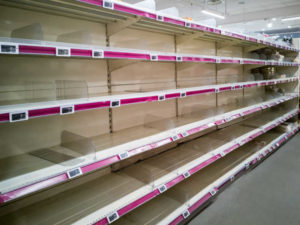
Businesses are preparing for the reality that food shortages could lead to violence around the world. The Wall Street Journal’s Richard Vanderford notes that “Food costs are higher now than in 2007 and 2008, when then-record prices led to protests and riots in 48 countries, according to a United Nations report.”
Are you prepared for a food shortage? The hype around food shortages may be overblown, but do you want to take that risk? Developing a food security plan is important no matter what’s happening, and with the situation as bad as it is today, you want to be ahead of the game. Start your planning by reading my special report FOOD SHORTAGE: Crazed Hoarding Is not Preparing.
Vanderford continues:
Though food prices have dipped slightly from highs reached in the immediate aftermath of Russia’s invasion of Ukraine, they were still about 44% higher in July than in 2020, according to a food-price index compiled by the Food and Agriculture Organization of the United Nations.
“We’re seeing across the world a much higher potential exposure to civil unrest as people see their purchasing power falling quickly,” said Jimena Blanco, the head of the Americas research team for risk-intelligence company Verisk Maplecroft.
High fertilizer prices in particular have led to far-flung impacts. In Peru and Greece earlier this year, farmers took their trucks and tractors to urban centers to voice their aggravation. Sri Lankan protesters stormed the presidential palace and forced a change in administration, a move analysts have attributed in part to a ban on chemical fertilizers that shrank crop yields. The uprising in Sri Lanka was a conspicuous illustration of the volatile forces a disappointing harvest can unleash in short order.
At least 50 countries depend on Russia and Ukraine for 30% or more of their grain supplies, including many developing countries in North Africa and Asia, according to a report from Marsh. Turkey, for example, imported 78% of its wheat from Russia and Ukraine in 2020, while Brazil is the main market for Russian fertilizers, Marsh said.
Not all countries face the same risks from rising prices. Rich democracies with the resources to absorb price increases, for example, are likely to fare better. Countries at risk tend to have some commonalities: They are autocracies, they rely on imported food and they have had subsidies they can no longer afford, said Marsh’s Mr. Robson.
The widespread quantitative belt-tightening, along with the impact of Covid-19 on public treasuries, could hurt some countries’ ability to dole out the food subsidies that had staved off unrest in the past, he said.
“With authoritarian regimes, you’re going to see a high likelihood of a pattern of increased civil disobedience, which would become dramatic in some countries,” Mr. Robson said. “I do think the circumstances in the short term will be extremely difficult.”
Mr. Robson added that in the longer term—12 to 18 months—steps could be taken to increase global food production and improve the situation.
Action Line: Twelve to eighteen months? That’s a long time to suffer from food insecurity. Don’t put your family in that position. Download my special report FOOD SHORTAGE: Crazed Hoarding Is not Preparing today, and get started on preparing a plan for your family.



